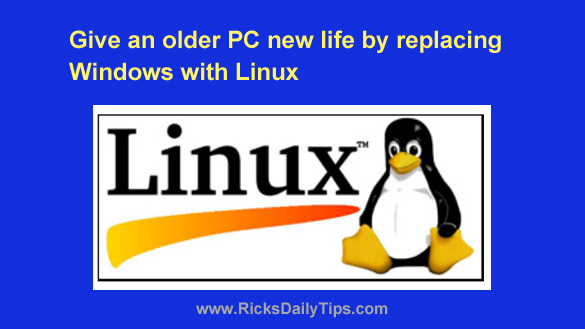
In this post I’m going to explain what Linux is, and more importantly, what it can do for you as the owner of an older PC that’s running a version of Windows that has been abandoned by Microsoft.
As you probably know by now, Microsoft is no longer releasing security updates for many versions of Windows, which means computers that are still running them are wide open to hackers and malware.
But an awesome free operating system called Linux can make using that unsafe computer safe again.
The vast majority of the world’s desktop and laptop computers Windows machines or Macs, so there’s a good chance that you’ve never heard of Linux. We’re about to change that…
In 1991, a software engineer by the name of Linus Torvalds released the Linux kernel, the body of code that today serves as the foundation for a number of different Linux versions (aka Distributions, or Distros).
Each of the various Linux distros that are available today have a few of their own individual characteristics, but they are all basically the same “under the hood”. They all understand the most common Linux commands and syntax, and they can all be downloaded for free.
While you can purchase commercial versions of Linux (Red Hat Enterprise Linux for example), all of the base Linux distros themselves are completely free for the taking.
While there are still relatively few desktop PCs and laptops running Linux compared to Windows machines and Macs, the majority of the world’s web servers are running it. And Linux also powers many broadband routers, game consoles and a wide range of other tech gadgets.
What’s more, if you own an Android tablet or smart phone, the Android operating system that’s running on it is a derivative of Linux!
By now you’re probably wondering what all of this means to you…
Well, maybe nothing. But if you have an older PC that’s running Windows XP, Windows 7, Windows 8.1 or even early versions of Windows 10, you can replace Windows with Linux for free and give that dusty old machine a brand new life!
Replacing older versions of Windows with Linux can be a great move, for the following reasons:
1 – Speed – Thanks to its more efficient use of the typical computer’s hardware components, the leanest versions of Linux will almost always run faster than Windows when installed on the same computer. Therefore, replacing Windows with Linux will almost always result in a faster PC.
2 – Security – Machines running Linux are currently less susceptible to malware attacks than Windows machines, even with no third-party anti-malware software installed on them.
3 – Ease of Use – If you primarily use your computer to visit websites, send/receive emails and/or use Facebook or Twitter, you’ll find that the learning curve you’ll encounter after switching from Windows to Linux is minimal.
You’ll be able to use the same web browser(s) you used with Windows, including Microsoft Edge, Firefox and/or Chrome.
If Firefox is your preferred browser, you’ll be happy to learn that it’s already installed and ready to use when you finish installing most versions of Linux, including the popular Linux Mint and Ubuntu.
4 – It’s Free – You’ll be able to download and install Linux for free, and all updates will be free forever as long as you choose a free version of Linux (which the overwhelming majority of folks do).
As mentioned above, the learning curve when switching to Linux will be quite low if you primarily use your computer for Internet-related tasks.
That being said, if you use any offline programs such as Photoshop Elements or Microsoft Office, you’ll need to switch to Linux replacement programs that perform the same tasks as your current Windows programs.
The good news about switching to Linux-based applications is you’ll be able to download them for free. While there will indeed be a learning curve after installing the new programs, they are usually relatively easy to learn, and many of them have tons of free online training and forum support available.
Luckily, the various graphical user interfaces that are installed along with most modern Linux distros work very much like Windows. Yes, the menus might be in different places on the screen and the options might vary a bit, but for the most part everything is very intuitive and easy to learn.
If you give Linux a try and decide that you like it, you’ll find tons of useful (and free) training videos and tutorials on the Internet.
A great place to start is over at The Linux Foundation.
Bottom line: Replacing Windows with Linux is a free and effective way to give most any older Windows PC a new lease on life. Why send a perfectly good computer to the recycling center when you can keep right on using it for several more years?